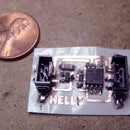Introduction: Lasercut Stretchy Conductive Fabric Traces
How to make conductive fabric traces from non-stretchy fabric and attach them to stretchy fabric.
You will need:
You will need:
- Conductive fabric. I used Cobaltex from Less EMF http://www.lessemf.com/fabric.html
- Wonder Under or some other iron-on adhesive sheeting (you can get it at fabric stores)
- Laser cutter
- Clothing iron
- Flux
- Soldering iron
- Stuff you want to solder
- rhinestone glue (like Gemtac) for gluing your components to the fabric.
Step 1: Ironing on the Wonder Under
First you need to iron the wonder under onto your piece of conductive fabric. Put the glue side down and iron on low until the glue melts enough to stick to the fabric. If you iron it too long or too high, the glue will disappear into the fabric, and that's not so great.
Leave the paper on, that is the side that you will be lasercutting.
Leave the paper on, that is the side that you will be lasercutting.
Step 2: Laser Cut the Fabric
You want to laser cut the fabric with a pattern so that even though the fabric itself doesn't stretch, the structure will. I included some samples in the .dxf file below, copy them to the sizes of your fabric.
The laser cutter settings that you use should cut through the paper and fabric without burning away too much excess fabric. For our lasercutter (a really old Universal) that means the following settings:
The laser cutter settings that you use should cut through the paper and fabric without burning away too much excess fabric. For our lasercutter (a really old Universal) that means the following settings:
- Vector cut
- 1000 PPI
- 45% power
- 40% speed
Step 3: Ironing on the Traces
I use a mini iron (a quilter's iron for patches and applique stuff) to iron on the traces because I'm clumsy. But you can use a regular clothing iron too.
Mark where you want your traces beforehand (with tape or pencil) so that you can be sure you don't have any overlap. If you need to cross traces, iron on one trace first, and sandwich with a small piece of heavy non-conductive fabric so that the fabric doesn't touch.
Peel the paper backing off the traces and iron them on. Keep at least 1.5 cm of spacing between ground and signal traces.
Mark where you want your traces beforehand (with tape or pencil) so that you can be sure you don't have any overlap. If you need to cross traces, iron on one trace first, and sandwich with a small piece of heavy non-conductive fabric so that the fabric doesn't touch.
Peel the paper backing off the traces and iron them on. Keep at least 1.5 cm of spacing between ground and signal traces.
Step 4: Snaps As Connectors for Non-washable Components.
LEDs, piezo transducers, small buttons and the like are generally washable. Some more expensive components however you might not want to just stick in the washing machine. In the dress I used a bluetooth module and some speaker drivers I decided I wanted to remove when washing, so I used snaps to make the connections.
Sew the snaps onto the ends of the traces with conductive thread, making it plenty tight. For good measure you can make sure it doesn't fray with a dab of thread end glue. Solder the other end of the snaps onto the end of your signal wires. To make sure that I don't get ground and signal wires mixed up, I used differently sized snaps for the two.
Sew the snaps onto the ends of the traces with conductive thread, making it plenty tight. For good measure you can make sure it doesn't fray with a dab of thread end glue. Solder the other end of the snaps onto the end of your signal wires. To make sure that I don't get ground and signal wires mixed up, I used differently sized snaps for the two.
Step 5: Soldering on the Washable Components
The fabric is metal coated polyester, so if we heat it for too long, the polyester part will burn. To avoid this, try to get an adjustable soldering iron and use low-temperature solder, and solder the components as quickly as possible. Brush flux onto the places where you are going to solder. Pre-tin the components by adding solder to them before you connect them to the trace. Then touch the soldering iron to the component and the trace on the fabric as quickly as possible.
After you solder the component onto the end, it is best to reinforce the mechanical connection by ironing on another heavy piece of fabric with some wonder under. Then you can glue the component down with some rhinestone glue (like Gem-tac).
Another way to do this is to create rings at the ends of the lead of your components and to sew them in with conductive thread. This is more laborious, and with my sewing skills less durable.
After you solder the component onto the end, it is best to reinforce the mechanical connection by ironing on another heavy piece of fabric with some wonder under. Then you can glue the component down with some rhinestone glue (like Gem-tac).
Another way to do this is to create rings at the ends of the lead of your components and to sew them in with conductive thread. This is more laborious, and with my sewing skills less durable.
Step 6: Care and Repairs
In my experience what is the most fragile is the traces getting unglued. You can generally fix this by ironing over them again, but if the iron on glue has soaked into the fabric beneath you might need to add some extra (heat setting) fabric glue. My dress was OK in the washing machine on the woollen cycle, but it would probably last longer if you hand wash.






